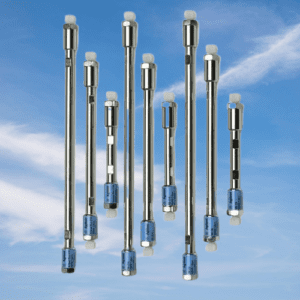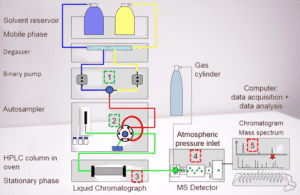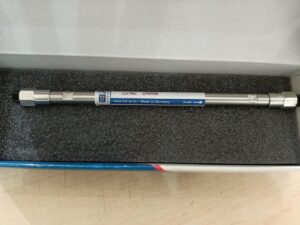High-performance liquid chromatography hplc columns are crucial components of the HPLC system, which is an analytical technique used to separate, identify, and quantify components of a mixture. HPLC columns consist of a cylindrical tube packed with a stationary phase material, which interacts with the sample components to separate them based on their physical and chemical properties.
Here are some important points to understand about HPLC columns:
Stationary Phase: The stationary phase is the material packed inside the column. It can be a solid (commonly called a packed column) or a porous material (known as a capillary column). The choice of stationary phase depends on the nature of the analytes and the separation goals. Common stationary phases include silica, C18 (octadecylsilane), C8 (octylsilane), phenyl, and cyano phases.
Particle Size: The stationary phase material is available in different particle sizes, typically ranging from 3 to 10 μm. Smaller particle sizes provide higher resolution but may require higher pressures to maintain the flow rate.
Column Length and Diameter: HPLC columns come in various lengths and diameters. The column length affects the separation efficiency, with longer columns providing better resolution. The column diameter impacts the flow rate and the system pressure. Common column lengths range from 50 to 250 mm, while diameters typically range from 2 to 4.6 mm.
Column Types: There are different types of HPLC columns, including:
a. Analytical Columns: Used for routine analysis and typically have internal diameters of 2-4.6 mm.
b. Guard Columns: Smaller columns placed in-line before the analytical column to protect it from contamination and extend its lifetime. Guard columns are easier and cheaper to replace than the main analytical column.
c. Preparative Columns: Larger columns designed for purification and isolation of larger amounts of sample compounds. These columns have a higher capacity and can handle higher flow rates.
Column Chemistry: The choice of column chemistry depends on the sample’s nature and the separation requirements. For example, a C18 column is commonly used for the analysis of hydrophobic compounds, while a silica column is suitable for polar compounds.
Mobile Phase: The mobile phase, typically a mixture of solvents, flows through the column, carrying the sample components. The composition and properties of the mobile phase affect the separation and elution of analytes.
Separation Modes: HPLC columns can operate in different separation modes, including:
a. Reversed-Phase Chromatography: The stationary phase is nonpolar, and the mobile phase is polar. This mode is widely used for separating nonpolar and moderately polar compounds.
b. Normal-Phase Chromatography: The stationary phase is polar, and the mobile phase is nonpolar. It is suitable for separating polar and moderately polar compounds.
c. Ion-Exchange Chromatography: The stationary phase contains charged groups that interact with charged analytes. It is used for separating ions and charged molecules.
d. Size-Exclusion Chromatography (SEC): Also known as gel permeation chromatography (GPC), it separates analytes based on their size or molecular weight.
These are some of the key aspects to consider when working with HPLC columns. The selection of the appropriate column depends on the specific separation requirements and the nature of the analytes being analyzed.
Types of hplc column as per usp
Exploring the USP-Defined Types of HPLC Columns: A Comprehensive Journey into Chromatographic Classification
Within the realm of High-Performance Liquid Chromatography (HPLC), the United States Pharmacopeia (USP) serves as a beacon of guidance, providing standardized definitions and classifications for various column types. These USP-defined column types offer a framework that ensures consistency and reliability in pharmaceutical analysis. Let us embark on a comprehensive journey, delving into the distinct types of HPLC columns as defined by the USP.
- L1 – Octadecyl Silane (ODS or C18): The L1 category encompasses the widely used Reversed-Phase (RP) columns featuring an octadecyl silane stationary phase bonded to a silica support. These columns find extensive applications in pharmaceutical analysis, enabling the separation of nonpolar and moderately polar compounds.
- L3 – Cyano: The L3 category comprises Cyano columns, which feature a stationary phase with a cyano group (-CN). These columns offer an alternative selectivity compared to C18 columns, particularly for polar compounds and analytes with hydrogen-bonding capabilities.
- L7 – Diol: Diol columns, falling under the L7 category, consist of a stationary phase with hydroxyl (-OH) functional groups. They are primarily employed for the separation of highly polar compounds, including sugars, organic acids, and water-soluble vitamins.
- L10 – Phenyl: The L10 category encompasses Phenyl columns, which possess a stationary phase functionalized with a phenyl group. These columns offer unique aromatic interactions and are particularly useful for the separation of compounds with aromatic moieties or analytes exhibiting π-π interactions.
- L11 – Amino: Amino columns, falling under the L11 category, feature a stationary phase with amino (-NH2) functional groups. These columns offer enhanced selectivity for polar compounds, especially those capable of forming hydrogen bonds or exhibiting basic properties.
- L32 – Ion Exclusion: The L32 category represents Ion Exclusion columns, which specialize in the separation of charged and ionizable compounds. These columns employ a stationary phase designed to exclude ions, allowing the separation of ionized and non-ionized species.

These USP-defined HPLC column types provide a standardized framework for pharmaceutical analysis, ensuring consistency and comparability across laboratories. Each column type offers specific selectivity and separation characteristics, enabling scientists to tailor their method development and analysis based on the unique requirements of their pharmaceutical samples.
It is worth noting that the USP also provides additional guidelines and specifications for HPLC column performance, including column efficiency, resolution, and system suitability criteria. These guidelines further contribute to the reliability and reproducibility of HPLC analyses within the pharmaceutical industry.
As we navigate the realm of HPLC column types according to the USP, we gain a deeper appreciation for the importance of standardization and classification in chromatographic analysis. The USP-defined column types serve as valuable tools, ensuring the integrity and quality of pharmaceutical analysis, and propelling us toward greater scientific achievements and advancements in pharmaceutical sciences.
hplc column List
- Reversed-Phase Columns:
- C18 (Octadecyl Silane)
- C8 (Octyl)
- C4 (Butyl)
- C2 (Ethyl)
- Normal-Phase Columns:
- Silica
- Diol
- Amino
- Specialty Columns:
- Phenyl
- Cyano
- Pentafluorophenyl (PFP)
- Chiral
- Ion-Exchange Columns:
- Strong Cation Exchange (SCX)
- Strong Anion Exchange (SAX)
- Weak Cation Exchange (WCX)
- Weak Anion Exchange (WAX)
- Size Exclusion Columns:
- Gel Filtration Columns
- Gel Permeation Columns
- Molecular Sieve Columns
- Affinity Columns:
- Immobilized Protein A/G
- Immobilized Enzymes
- Lectin Columns
- Antibody Columns
It’s important to note that this is not an exhaustive list, and there are other specialized columns available for specific applications. The choice of HPLC column depends on the nature of the analytes, desired separation mechanism, and the specific requirements of the analysis.
hplc column length
HPLC columns come in various lengths, which can impact chromatographic separation and analysis. The column length refers to the physical length of the stationary phase within the column. Here are some standard HPLC column lengths used in the chromatographic analysis:

- Short Column (≤ 5 cm): Short columns are typically used for fast separations and can provide rapid analysis with reduced retention times. They are suitable for applications where speed is crucial, such as high-throughput analysis.
- Medium Column (10 – 15 cm): Medium-length columns are commonly used in routine HPLC analyses. They offer a good balance between separation efficiency and computation time, making them suitable for a wide range of applications.
- Long Column (≥ 25 cm): Long columns are employed when high separation efficiency and resolution are required. These columns provide excellent peak resolution but may require longer analysis times. They are often used for complex samples or when separating closely eluting compounds is necessary.
The choice of column length depends on various factors, including the complexity of the sample, desired resolution, analysis time, and available equipment. It is important to consider the specific requirements of the analysis and select an appropriate column length accordingly.
hplc column volume calculator
Column Volume (V) = π * (Column Length) * (Column Inner Diameter / 2)^2
Where:
- V represents the column volume
- π is a mathematical constant approximately equal to 3.14159
- Column Length refers to the length of the column in centimeters
- Column Inner Diameter is the inner diameter of the column in millimeters
To calculate the column volume, follow these steps:
- Measure the length of the column in centimeters.
- Determine the inner diameter of the column in millimeters.
- Divide the inner diameter by 2 and square the result.
- Multiply the squared value by π.
- Multiply the result by the column length.
The final value obtained will represent the column volume in cubic centimeters (cm³) or milliliters (mL).
Remember to use consistent units throughout the calculation (e.g., convert millimeters to centimeters if necessary) to ensure accurate results.
What is C8 and C18 column?
| Property | C8 Column | C18 Column |
|---|---|---|
| Stationary Phase | Octylsilane bonded to silica | Octadecylsilane bonded to silica |
| Retention | Lower retention compared to C18 | Higher retention compared to C8 |
| Selectivity | Suitable for less polar compounds | Suitable for more polar compounds |
| Separation Efficiency | Lower efficiency compared to C18 | Higher efficiency compared to C8 |
| Hydrophobicity | Moderate hydrophobicity | Higher hydrophobicity |
| Recommended Applications | Separation of moderately polar compounds, pharmaceutical analysis | Separation of polar and nonpolar compounds, environmental and food analysis |
| Sample Compatibility | Limited compatibility with highly polar samples | Suitable for a wide range of sample types |
| Method Development | Offers different selectivity options | Widely used and established |
Frequently Asked Questions
What is the purpose of a stationary phase in an HPLC column?
Answer: The stationary phase in an HPLC column is responsible for the separation of analytes based on their interactions with the stationary phase material. It provides the selectivity and retention mechanism for chromatographic separations.
How does the particle size of the stationary phase affect chromatographic separations?
Answer: Smaller particle sizes provide higher efficiency and better resolution due to increased surface area, but they require higher backpressure. Larger particles are more suitable for preparative HPLC and can withstand higher flow rates.
What is the significance of the stationary phase chemistry in HPLC column selection?
Answer: The stationary phase chemistry determines the type and strength of interactions between the analytes and the stationary phase. It plays a vital role in achieving the desired selectivity and separation of target compounds.
What are the factors to consider when choosing the appropriate column length for an HPLC analysis?
Answer: Factors to consider include the desired separation resolution, analysis time, sample complexity, and instrument capabilities. Longer columns offer higher resolution but may increase analysis time.
What is the difference between a reversed-phase and a normal-phase HPLC column?
Answer: Reversed-phase columns use hydrophobic stationary phases and polar mobile phases, while normal-phase columns use polar stationary phases and nonpolar mobile phases. Reversed-phase is more commonly used in HPLC due to its versatility and wider range of applications.
How does the selection of mobile phase composition impact the performance of an HPLC column?
Answer: The mobile phase composition affects analyte retention, selectivity, and separation. Changing the solvent strength, pH, or adding modifiers can alter chromatographic behavior and optimize separations.
What is the effect of temperature on HPLC column efficiency and selectivity?
Answer: Temperature influences column efficiency by affecting the mobile phase viscosity and analyte diffusivity. It can also alter selectivity by changing the interactions between the analytes and the stationary phase.
How do different column dimensions, such as inner diameter and length, affect chromatographic performance?
Answer: Smaller inner diameters provide higher column efficiency but require higher backpressure. Longer columns increase resolution but may prolong analysis time. Column dimensions should be optimized based on the desired separation goals.
What is the role of column equilibration in achieving reproducible and reliable HPLC results?
Answer: Column equilibration ensures that the stationary phase is in a stable and consistent state before sample injection. Equilibration removes contaminants, stabilizes baseline, and ensures reproducibility of results.
How can column conditioning and storage practices impact the longevity and performance of HPLC columns?
Answer: Proper conditioning of new columns removes impurities and stabilizes the stationary phase. Storage in a clean and dry environment, with appropriate protective measures, helps preserve column integrity and prolong its lifespan.

